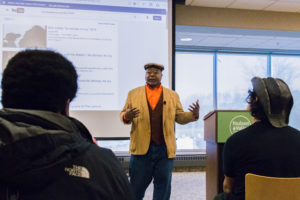Bob Marley event held for Black History Month
Setodzi Avoke
Junior Copy Editor

In recognition of of both Black History Month and Bob Marley’s birthday, Hudson Valley hosted a lecture titled “Bob Marley & the Wailers.”
On Feb. 23, guest speaker Donald Hyman recounted the life, music and influence of Bob Marley, born Robert Nesta Marley. Hyman also touched on the history of those who would work with, influence and be influenced by Marley.
These people ultimately contributed to the globe spanning legacy left behind by Marley.
Hyman’s presentation opened with a history of “Bob Marley & the Wailers,” particularly the “lesser known” members Bunny Livingston and Peter Tosh, which quickly transitioned to the Trench Town municipality of Kingston where all three young men lived and collaborated at one point.
Hyman explained that Trench Town was constructed as a lower income housing development and the area began as a step up for the citizens of Kingston. Years later it would become violent as the People’s National Party and the Jamaica Labour Party would enforce discriminatory measures that turned housing and services into a partisan issue.
Hyman felt it was worth the diversions to impart a sense of context for the work Bob Marley and his acquaintances would create. For example, to understand Bob Marley’s “No Woman, No Cry,” it was necessary to know the conditions he would face while living there.
From Trench Town, Hyman covered Marley’s managerial dissatisfaction, conversion to Rastafarianism, headlining role in the development of Ska and Reggae, marriage, children, rising fame, assassination attempt, mortal struggle with skin cancer and more.
Marley’s work often included a sense of peace and cooperation which can be found in songs like “Simmer Down” that implores the “rude boys” or lawless urban youths of Jamaica to put down their weapons and reduce the violence in Kingston in the 1960s.
Peace and cooperation, according to Hyman, are pursuits with an international and intercultural importance to them, but in his study of Marley’s work had an underlying message of black history and civil rights struggles.
“If you’re going to look at Bob Marley’s influence, he’s international [and] he represents humanity in his own way, but he also puts forth a way of [analyzing] [black] culture and not overlooking it,” said Hyman.
“Rather than just bump and grind music, he talks about the fact that [significant portions of the Black-American population] were in slavery,” he said.
In Marley’s music, Hyman hears a record of black strengths, weaknesses, creativity and unity.
“We don’t necessarily look at [Marley] as an entertainer, but as a messenger which is actually what his name, Nester, [means],” said Hyman.
Hyman’s presentation urged listeners to understand the man before the “Legend.”
“Whether they’re white, black, Hispanic or Asian, people will be wearing Bob Marley t-shirts,” said Hyman. “He’s become a cultural figure that has transcended Jamaican and black culture. He’s become youth culture [and] people culture,” said Hyman.
